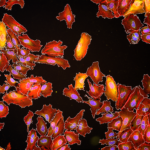Lien vers Pubmed [PMID] – 21504731
Biophys. J. 2011 Apr;100(8):1949-59
Septins are conserved GTPases that form filaments and are required for cell division. During interphase, septin filaments associate with cellular membrane and cytoskeleton networks, yet the functional significance of these associations have, to our knowledge, remained unknown. We recently discovered that different septins, SEPT2 and SEPT11, regulate the InlB-mediated entry of Listeria monocytogenes into host cells. Here we address the role of SEPT2 and SEPT11 in the InlB-Met interactions underlying Listeria invasion to explore how septins modulate surface receptor function. We observed that differences in InlB-mediated Listeria entry correlated with differences in Met surface expression caused by septin depletion. Using atomic force microscopy on living cells, we show that septin depletion significantly reduced the unbinding force of InlB-Met interaction and the viscosity of membrane tethers at locations where the InlB-Met interaction occurs. Strikingly, the same order of difference was observed for cells in which the actin cytoskeleton was disrupted. Consistent with a proposed role of septins in association with the actin cytoskeleton, we show that cell elasticity is decreased upon septin or actin inactivation. Septins are therefore likely to participate in anchorage of the Met receptor to the actin cytoskeleton, and represent a critical determinant in surface receptor function.



